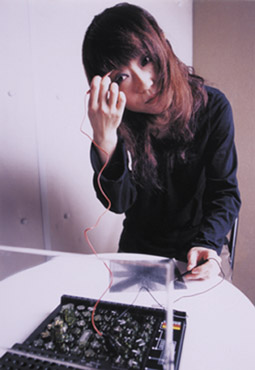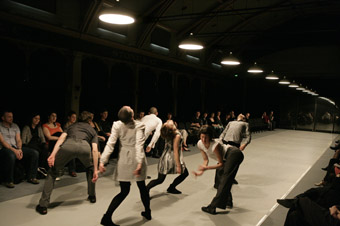a branching practice
gail priest: interview with haco

Haco with her Pencil Organ
courtesy the artis
Haco with her Pencil Organ
ONE ARTIST I REALLY WANTED TO MAKE CONTACT WITH WHEN RECENTLY IN JAPAN WAS THE INSPIRATIONAL VOCALIST, PRODUCER AND COMPOSER HACO. IT TURNED OUT THAT SHE WAS IN MELBOURNE AT THE TIME DEVELOPING THE SOUNDTRACK FOR LUCY GUERIN INC’S CORRIDOR BUT ON MY RETURN I JUST MANAGED TO CATCH HER AS SHE WAS BACK IN TOWN FOR THE SHOW’S OPENING. ON OUR WAY TO CHECK OUT 21:100:100 (SEE REVIEW) WE TALKED ABOUT THE BREADTH OF HER PRACTICE AND HER VARIED APPROACHES TO TECHNOLOGY, TECHNIQUES AND COLLABORATION.
Haco first became known through her band After Dinner (1981-91). This early work attracted attention in international experimental music scenes because it combined both Haco’s melodic vocal stylings along with musique concrete techniques. Haco explains: “Nothing digital…we worked with tape splicing. In 1980, I learned recording technology and electronics, music like Stockhausen. I was really interested in tape music. It was really like sampling…We just tried to combine that sort of stuff in a natural balance.”
After Dinner had a shifting line-up of musicians depending on the specifics of the project, and this varied approach to collaboration is perhaps what makes Haco’s practice so interesting. It appears as though each collaboration inspires a particular tangent, or methodology.
On Yesterday’s Heroes,1979 (La Louche, 2004) Haco worked with Terre Thaemlitz to create the new wave band that they wished they had been in back in 1979, recasting their pasts by drawing on their present skills. On the 2000 release Ohayo! Hoahio! (Tzadik, TZ 7230, 2000) she worked with koto player Yagi Michiyo and minimal electronics mistress Sachiko M creating a veritable mixage of genres ranging from pop, to improv and minimalism.
Particularly interesting is her collaboration with cellist Hiromichi Sakamoto. After playing an improvised concert with him, she was listening to his CD and decided that there were hidden melodies in his work. She went on to “redo” his album, remixing and augmenting it to create a new work, Ash in the Rainbow (ReR HACO3, 2003). I asked if he thought this a bit forward of her, but she says that “he was quite happy. He sent new tracks, and we made a tour in Europe together.”
Yet another project sees her working with French Canadian improv artists Martin Tétreault and Dianne Labrosse. After meeting them during a tour in Europe Haco invited them to her studio in Kobe where they ‘cooked’ together. The resulting recording, Lunch in Nishinomiya (Improvised Music from Japan, IMJ-527, 2005), was then mixed and finalised via email.
I asked Haco what she is seeking from these collaborations: is it a pursuit of like-mindedness or difference? She replies: “Maybe a similarity, but not the same. I really love when someone brings me another idea. If I work alone, like on a solo album it’s quite different. But totally different ideas come from [other people]. Even melodic material…”
While her work with others shifts her approaches, Haco’s solo practice also seeks out different directions, technically and conceptually. Parallel to her more pop oriented work she has also pursued more esoteric sound making methodologies. From 2002 to 2005 she was part of View Masters, an environmental sound project that ran annual lectures and performances. During this time she developed her Stereo Bugscope system where she mikes up various devices capturing their electrical oscillations. It was through this work that I first became aware of Haco when she performed a version at Artspace, Sydney during Caleb K’s Typhoon (2005). I’d never imagined that the loading of a blank CD into the hard drive of a computer could be so sonically intriguing. Her explorations of home constructed electronics have continued with creations like the Pencil Organ made from a home electronics kit which allows the human body to become part of the circuitry. Haco is comfortable with diversification in her practice: “My work is quite branched to each project, becoming more conceptual…I enjoy making separate things.”

Corridor, Lucy Guerin Inc
photo Jeff Busby
Corridor, Lucy Guerin Inc
While the majority of Haco’s collaborations have been with other musicians and sound artists, she is also interested in working across disciplines. Corridor, premiered at this year’s Melbourne Festival, marks Haco’s second collaboration with Lucy Guerin, the first being, Setting, a dance work developed in a Japanese exchange and for the Melbourne Festival in 2006.
To create the soundtrack for Corridor, Haco wandered the streets of Melbourne, sidling up close to people to capture snippets of conversation. “I needed to do secret recordings. Getting close to people looking like I’m listening to a walkman. I went to a lot of places… a university, a hospital, Victoria Market, on the station, on the street, the art centre, the lobby of an office building…” Guerin then chose specific segments which Haco collaged into a 12 speaker soundscape (running under the audience seating) for the introductory scene of the work. An intriguing choice was the inclusion of a complete track from Haco’s latest album Riska—a sensual, jazzy number about the peace of being in the shower. While at first the lyrics create a slight tangent in the proceedings, they also add a level of solitary sensuality to a work that concerns itself more with the awkwardness of collectivity. Overall Haco’s soundtrack is subtle and restrained, present when it needs to be, but then quietly supportive, often adding layers without drawing attention to itself: all the signs of a sensitive collaborator.
Straight after Melbourne, Haco was going on to participate in the inaugural Nam Jun Paik festival in Seoul where she would be working with her latest collaborator Claudia Triozzi, a choreographer turned vocalist. “She is Italian so she [uses] some traditional opera [style], she has quite a wide range. It’s different from voice improvisation but quite experimental.” It seems that Haco’s collaborations will continue to be incredibly varied and feed the artist’s unique approach to music-making for a good while to come.
–
Riska is out now on Arcàngelo, ARC-1122, 2007
See also John Bailey’s review of Corridor.
RealTime issue #88 Dec-Jan 2008 pg. 44






